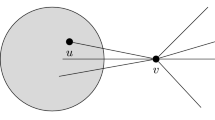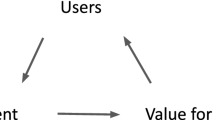Abstract
A community is sub-network inside P2P networks that partition the network into groups of similar peers to improve performance by reducing network traffic and high search query success rate. Large communities are common in online social networks than traditional file-sharing P2P networks because many people capture huge amounts of data through their lives. This increases the number of hosts bearing similar data in the network and hence increases the size of communities. This article presents a Memory Thread-based Communities for our Entity-based social P2P network that partition the network into groups of peers sharing data belonging to an entity–person, place, object or interest, having its own digital memory or be a part another memory. These connected peers having further similarities by organizing the network using linear orderings. A Memory-Thread is the collection of digital memories having a common reference key and organized according to some form of correlation. The simulation results show an increase in network performance for the proposed scheme along with a decrease in network overhead and higher query success rate compared to other similar schemes. The network maintains its performance even while the network traffic and size increase.














Similar content being viewed by others
References
E.P.S.R.C (2009). http://www.epsrc.ac.uk/Pages/default.aspx
Abbas SMA (2016) Design and analysis of social network systems (sns). Ph.D. thesis, Manchester Metropolitan University, UK
Ahmed R, Boutaba R (2011) A survey of distributed search techniques in large scale distributed systems. IEEE Commun Surv Tutor 13(2):150–167
Brown PJ (2004) GC3: Memory for life: getting things back. In: Grand challenges in computing research conference
Bush V (1945) As we may think. online. https://www.theatlantic.com/magazine/archive/1945/07/as-we-may-think/303881/
Cao X (2015) Semantic search and composition in unstructured peer-to-peer networks, Ph.D. thesis. SE - DFKI Deutsches Forschungszentrum für Künstliche Intelligenz. https://doi.org/10.22028/D291-25422
Crespo A, Garcia-Molina H (2004) Semantic overlay networks for p2p systems. In: International workshop on agents and p2p computing. Springer, pp 1–13
Ed-daoui I, El Hami A, Itmi M, Hmina N, Mazri T (2018) Unstructured peer-to-peer systems: towards swift routing. International Journal of Engineering and Technology 7(2.3):33–36
Ferrara E (2012) Mining and analyzing online social networks. Ph.D thesis
Fitzgibbon A, Reiter E (2003) Memories for life: Managing information over a human lifetime. UK Computing Research Committee Grand Challenge proposal 22:13–16
Franchi E, Poggi A, Tomaiuolo M (2019) Blogracy: a peer-to-peer social network. In: Censorship, surveillance, and privacy: concepts, methodologies, tools, and applications. IGI global, pp 675–696
Furno A, Zimeo E (2014) Self-scaling cooperative discovery of service compositions in unstructured p2p networks. J Parallel Distrib Comput 74(10):2994–3025. https://doi.org/10.1016/j.jpdc.2014.06.006. http://www.sciencedirect.com/science/article/pii/S0743731514001087
Gemmell J, Bell G, Lueder R (2006) Mylifebits: a personal database for everything. Commun. ACM (CACM) 49
Gemmell J, Bell G, Lueder R, Drucker S, Wong C (2002) Mylifebits: fulfilling the memex vision. In: Proceedings of the tenth ACM international conference on Multimedia. ACM, pp 235–238
Gong W, Jin R, Yang L, Huang D (2015) Enhanced entropy-based resource searching in unstructured p2p networks. Chin J Electron 24(6):229–235. https://digital-library.theiet.org/content/journals/10.1049/cje.2015.04.002
Hayes N (2000) Foundations of psychology Cengage Learning EMEA
Hsiao HC, Su HW (2012) On optimizing overlay topologies for search in unstructured peer-to-peer networks. IEEE Trans Parallel Distrib Syst 23(5):924–935
Hua C, Mao Y, Jinqiang H, Haiqing D, Xiaoming L (2004) Maze: a social peer-to-peer network. In: IEEE International conference on e-commerce technology for dynamic e-business. IEEE, pp 290–293
Humberd J, Humberd E (2001) Invitation to france: a “why-not-travel” rather than a “0how-to-travel” essay. Em J Pub
Ismail A, Merabti M, Llewellyn-Jones D, Sudirman S (2008) A framework for sharing and storing serendipity moments in human life memory. In: First IEEE international conference on ubi-media computing. IEEE, pp 132–137
Ismail A, Merabti M, Llewellyn-Jones D, Sudirman S (2009) Identifying personal memories and shared experience using p2p networks. In: The 10th annual conference on the convergence of telecommunications, networking and broadcasting (PGNet 2009). Citeseer, Liverpool, UK
Liu J, Wang G, Li D, Liu H (2015) Esr: an efficient, scalable and robust overlay for autonomic communications. In: Wang G., Zomaya A., Martinez G., Li K. (eds) Algorithms and architectures for parallel processing. Springer International Publishing, Cham, pp 415–429
Meng X, Jin J (2016) A free rider aware topological construction strategy for search in unstructured p2p networks. Peer Peer Netw Appl 9(1):127–141. https://doi.org/10.1007/s12083-014-0318-7
Meng X, Liu D (2016) A traffic-efficient message forwarding approach in unstructured p2p networks. Peer Peer Netw Appl 9(2):255–265. https://doi.org/10.1007/s12083-015-0326-2
Modarresi A, Mamat A, Ibrahim H, Mustapha N (2008) A community-based peer-to-peer model based on social networks. Int J Comput Sci Netw Secur 8(4):272–277
Modarresi A, Mamat A, Ibrahim H, Mustapha N (2009) Modeling and simulating semantic social overlay peer-to-peer systems. J Appl Sci 9(19):3547–3554
Mohs RC (2007) How human memory works. https://science.howstuffworks.com/life/inside-the-mind/human-brain/human-memory.htm
Naghizadeh A, Berenjian S, Meamari E, Atani RE (2016) Structural-based tunneling: preserving mutual anonymity for circular p2p networks. Int J Commun Syst 29(3):602– 619
Naghizadeh A, Berenjian S, Razeghi B, Shahanggar S, Pour NR (2015) Preserving receiver’s anonymity for circular structured p2p networks. In: 2015 12Th annual IEEE consumer communications and networking conference (CCNC). IEEE, pp 71–76
Ogino N, Kitahara T (2017) An efficient content search method based on local link replacement in unstructured peer-to-peer networks. IEICE Trans Commun advpub
Park H, Yang J, Park J, Kang SG, Choi JK (2008) A survey on peer-to-peer overlay network schemes. In: 2008 10Th international conference on advanced communication technology, vol 2. IEEE, pp 986–988
Priyanka C, Deeba K (2013) A comparative study on optimization of search in overlay networks. Int J Comput Sci 1(4)
Shen WW, Sen S, Shuang K, Yang FC (2010) SKIP: An efficient search mechanism in unstructured P2P networks. J China Univ Posts Telecommun 17(5):64–71
Stannat A, Pouwelse J (2019). A random walk based trust ranking in distributed systems. arXiv:1903.05900
Upadrashta Y, Vassileva J, Grassmann W (2005) Social networks in peer-to-peer systems. In: Proceedings of the 38th Annual Hawaii International Conference on System Sciences. IEEE, pp 200c–200c
Ur Rahman H, Merabti M, Llewellyn-Jones D, Sudirman S (2010) Investigating sharing in memory for life systems. In: The 11th annual conference on the convergence of telecommunications, networking and broadcasting (PGNet 2010). PG net
Ur Rahman H, Merabti M, Llewellyn-Jones D, Sudirman S (2011) An entity-based social peer-to-peer network for digital life memories. In: International conference on computer networks and information technology. IEEE, pp 13–19
Ur Rahman H, Merabti M, Llewellyn-Jones D, Sudirman S, Ghani A (2020) A community-based social p2p network for sharing human life digital memories. Trans Emerg Telecommun Technol n/a(n/a):e3866. https://doi.org/10.1002/ett.3866. https://onlinelibrary.wiley.com/doi/abs/10.1002/ett.3866
Venkadeshan R, Jegatha M (2018) Tmv: Trust-matrix-value based neighbor peer selection for secure query forwarding in P2P networks. In: Deshpande A, Unal A, Passi K, Singh D, Nayak M, Patel B, Pathan S (eds) Smart trends in information technology and computer communications. Springer, Singapore, pp 82–91
Author information
Authors and Affiliations
Corresponding author
Additional information
Publisher’s note
Springer Nature remains neutral with regard to jurisdictional claims in published maps and institutional affiliations.
Rights and permissions
About this article
Cite this article
Rahman, H.U., Merabti, M., Llewellyn-Jones, D. et al. Structuring communities for sharing human digital memories in a social P2P network. Peer-to-Peer Netw. Appl. 13, 1629–1642 (2020). https://doi.org/10.1007/s12083-020-00928-z
Received:
Accepted:
Published:
Issue Date:
DOI: https://doi.org/10.1007/s12083-020-00928-z




